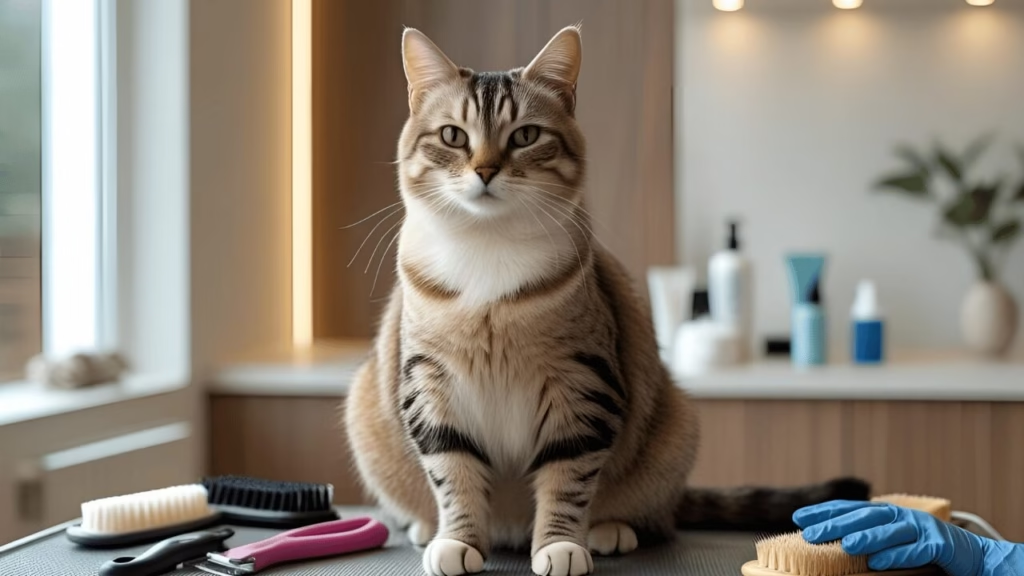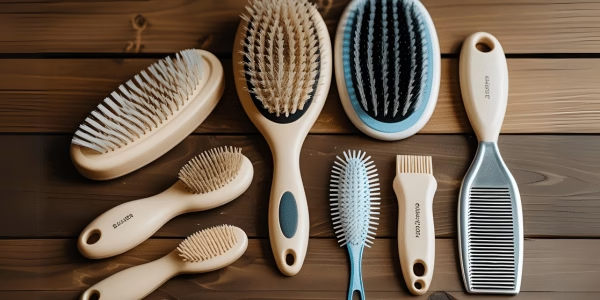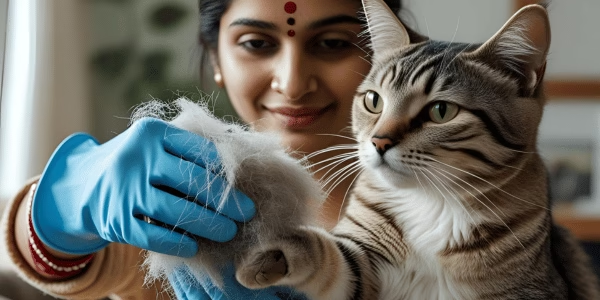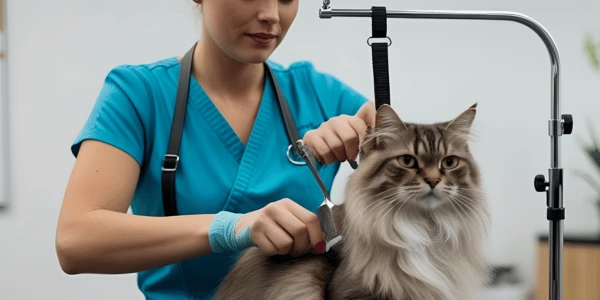Cats are among the cleanest creatures in the animal kingdom. Their instinctive grooming behaviors keep their coats clean and help them regulate body temperature. But while cats do a lot of self-maintenance, they still need regular grooming support from their humans. Whether your cat is a short-haired tabby or a long-haired Persian, the right grooming tools can make a world of difference in your cat’s comfort, appearance, and health.
This guide explores the most essential grooming tools for cats—with expert recommendations, updated product links, care tips, and usage frequency based on breed and lifestyle. Read on to build your complete grooming kit for 2025 and beyond.
We also have a dog version of this article, feel to read 15 Essential Dog Grooming Tools Every Owner Needs
Why Grooming Your Cat Is Essential
Routine grooming does more than keep your cat looking tidy—it’s vital to their health and happiness. The American Society for the Prevention of Cruelty recommends regular grooming. Here’s why:
- Reduces Shedding: Brushing captures loose fur that would otherwise end up on furniture or ingested by your cat.
- Prevents Mats and Tangles: Long-haired cats are prone to painful mats that can lead to skin infections.
- Controls Hairballs: Removing loose hair externally means less is swallowed during self-grooming.
- Supports Skin Health: Grooming distributes natural oils and boosts circulation.
- Improves Nail Health: Regular trimming prevents overgrowth and reduces damage to furniture.
- Facilitates Early Detection: Grooming gives you a chance to check for bumps, parasites, or wounds.
Some of the external links in this page are affiliate links, and I’m earning a commission if you purchase through them.
7 Cat Grooming Tools every cat guardian need
1. Brushes and Combs
Purpose: Remove dirt, dander, loose fur, and tangles while stimulating the skin.
Choosing the right brush depends on your cat’s coat type:
| Brush Type | Best For | Description |
|---|---|---|
| Slicker Brush | Medium to long-haired cats | Fine wires tackle mats, tangles, and loose undercoat hair. |
| Bristle Brush | Short-haired cats | Soft bristles gently remove dust and finish grooming. |
| Deshedding Tool | Cats that shed heavily | Targets undercoat without damaging topcoat. Reduces shedding up to 90%. |
| Comb with Rotating Teeth | Sensitive-skinned cats | Glides through tangles with less pulling or discomfort. |
Top Picks:
How Often to Brush Your Cat
- Short-haired breeds: 2–3 times per week
- Medium-haired breeds: 3–4 times per week
- Long-haired breeds (e.g., Maine Coons, Persians): Daily brushing recommended
Always brush in the direction of the hair to prevent discomfort or hair breakage.
2. Nail Clippers and Grinders
Purpose: Prevent painful overgrowth, snags, and injuries to both cats and owners.
| Tool | Benefits |
|---|---|
| Scissor Clippers | Easy to handle for beginners; ideal for smaller paws. |
| Guillotine Clippers | Fast snip, but requires precision. |
| Electric Grinder | Gradually files nails down; safer if you’re nervous about cutting the quick. |
Recommended Tools:
How Often to Trim Your Cat’s Nails
- Indoor cats: Every 2–3 weeks
- Outdoor cats: Every 4–6 weeks (they naturally wear down claws on surfaces)
Always avoid cutting into the quick—the pink section of the nail that contains nerves and blood vessels.
3. Bathing and Coat Care Products
Purpose: While cats rarely need full baths, certain situations (flea infestations, skin conditions, or messes) require bathing.
- Waterless Shampoo: Perfect for quick, no-hassle cleanups.
- Hypoallergenic Shampoo: Ideal for cats with allergies or skin sensitivities.
- Detangling Spray: Eases brushing post-bath.
Recommended Products:
Bathing Tips
- Use lukewarm water and bathe in a secure, non-slip area (like a sink).
- Use only feline-specific shampoos—human products can cause irritation.
- Dry with a microfiber towel or use a low-heat pet dryer.
4. Ear and Eye Cleaning Tools
Purpose: Maintain cleanliness and prevent infections or mite build-up.
- Ear Wipes: Clean outer ear canals without inserting anything deep.
- Eye Wipes: Remove gunk and tear stains.
Best Products:
Clean weekly for flat-faced breeds like Persians, or monthly for others.
5. Dental Tools
Purpose: Fight plaque buildup and bad breath while preventing periodontal disease.
- Cat Toothbrush: Finger-style or angled soft-bristle.
- Enzymatic Toothpaste: Safe to swallow, flavored for cats.
- Dental Wipes: Easier to use if your cat refuses brushing.
Top Picks:
How Often to Clean Your Cat’s Teeth
- Ideally: 2–3 times per week
- Minimum: Once a week with dental wipes if brushing isn’t tolerated
6. Grooming Gloves and Stress-Free Tools
Purpose: Ideal for cats who dislike brushes. Mimics petting while removing loose fur.
These are great for older or skittish cats and for grooming the face and legs.
7. Grooming Mats and Tables
Purpose: Keeps your cat secure during grooming. Prevents slipping and injury.
8. Cleaning and Maintaining Your Tools
Clean grooming tools regularly to prevent bacterial buildup and extend lifespan:
- Wash brushes with mild soap and water weekly.
- Sanitize nail clippers with alcohol between uses.
- Store tools in a dry, sealed container or organizer.
9. When to Hire a Professional Cat Groomer
Some cats won’t tolerate home grooming—especially seniors, rescues, or double-coated breeds with heavy matting. A licensed groomer can help with:
- De-matting
- Sanitary shaving
- Full coat trims
- Medical grooming needs (e.g., hot spots, skin conditions)
Use platforms like Thumbtack or ask your vet for local referrals.
Visual Guide: Essential Cat Grooming Toolkit
Here’s a visual summary to help organize your grooming kit:
| Tool Category | Essential Item | How Often to Use |
|---|---|---|
| Fur Maintenance | Slicker brush, deshedding tool | 2–7 times/week |
| Nail Care | Clipper or grinder | Every 2–3 weeks |
| Bath Supplies | Waterless shampoo, cat towel | Monthly or as needed |
| Ear & Eye Care | Ear cleaner, eye wipes | Bi-weekly to monthly |
| Dental Hygiene | Toothbrush, toothpaste | 2–3 times/week |
| Stress-Free Tools | Grooming gloves, non-slip mat | As needed during grooming |
Final Thoughts: Build Your Cat’s Custom Grooming Kit
No single tool fits all cats. Take your time building a grooming kit tailored to your pet’s coat type, personality, and health needs. Start small—introduce one tool at a time and use positive reinforcement. Within weeks, grooming will become a bonding ritual that benefits you both.
Happy grooming!







